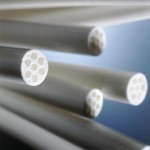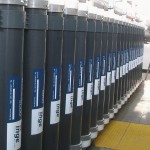Ultrafiltration combined with reverse osmosis provides an answer to the question of how industrial concerns can clean their water safely and efficiently. Although reverse osmosis has already become something of an industry standard, ultrafiltration has not yet achieved the same level of general acclaim despite offering huge advantages over conventional techniques. However, the benefits in terms of resilience, safety and cost-efficiency have become so overwhelming that nothing now stands in the way of UF and RO.
Last year, ultrafiltration specialist Inge watertechnologies unveiled the dizzer XL 0.9 MB 60 – the pinnacle of its new generation of products, featuring a 60 m² membrane surface area. Major advances in membrane geometry have boosted the water treatment capacity of this ultrafiltration module by 20 % – without any increase in the module’s size. Integrated in the T-Rack rack system, this compact alternative now boasts a footprint that is yet another degree smaller than conventional modular designs. The core component of the dizzer product line is the new generation of the patented Multibore membrane. Its optimised design increases permeability by almost a third while maintaining the same high levels of virus and bacteria retention. It also features superb enhancements to the honeycomb structure of the membrane´s geometry. The cross-section of a Multibore membrane reveals seven perfectly round capillaries. The company has succeeded in independently controlling two key factors in the production process, namely the thickness of the outer layer and the space between the capillaries. As a result, it is now possible to reduce the outer diameter from 4.3 to 4.0 mm while preserving the same outer layer thickness and the same capillary diameter (0.9 mm). This enables the membrane surface area to be increased from 50 m² to 60 m². At the same time, there is virtually no contact between the membranes in the modules, which is an important aspect in maintaining the correct operating pressure: the fewer the points of contact between the membranes, the lower the pressure loss.
Peter Berg, Chief Technology Officer of Inge: “It is not possible to increase the density of conventional, single-bore membranes to this extent without causing stability problems or hydrodynamic losses.“
Small footprint
For operators of water treatment plants, the advantages of the Multibore membrane combined with the latest dizzer generation represent yet another good reason to opt for ultrafiltration technology. There are enormous cost benefits to be achieved, in particular due to the footprint being so much smaller than that of traditional-style systems. The fully plumbed T-Rack – which Inge can equip with up to 80 dizzer modules depending on the treatment capacity required – already takes up around 50 % less space than a conventional rack, and the increased density in the dizzer module has now reduced its footprint by a further 20 %. This compact and efficient design not only cuts capital costs but also generates a long-term reduction in operating costs. In the words of Bruno Steis, Inge’s CEO: “These economic benefits, combined with the peace of mind of knowing that there is no risk of fibre breakage, are powerful arguments in favour of our technology. We provide a standard warranty stating that no fibre breakage will occur for a period of five years. Our systems have already been successfully implemented in more than 500 facilities worldwide and we have not witnessed a single case of breakage – even after eight years of operation.”
Endurance test passed with flying colours
The challenging environments in which the membranes have excelled reveal some impressive feats of endurance. One of the most outstanding examples involves a re-finery in China, a country where massive industrial growth has led companies to consider alternative water sources in order to meet the demand. CNPC Dalian Petrochemical Company Ltd. decided that the best option for supplying water to its refinery would be to reclaim treated secondary municipal waste water using a reverse osmosis (RO) system. UF pretreatment prior to RO is often specified for boiler feed water projects in China due to its excellent technical performance and competitive cost structure.
One of the most important steps when preparing a waste water feed for RO is to reduce turbidity, SDI and TOC in order to control fouling and minimise the need for chemical cleaning. At the Dalian plant, the secondary effluent feed from the municipal works is biologically treated and flocculated with alum prior to flotation and filtration. This ensures that the UF-RO has a consistent feed quality with a reduced concentration of dissolved organics (DOC) and nitrogen. Joachim Georgi – Managing Director of plant manufacturer GWT – explains further: “The membranes have shown that even a challenging feed such as municipal effluent can successfully be treated by UF, with only minimal chemical usage. This plant demonstrates that waste water reclamation represents a feasible alternative for industrial water requirements.”
Another company that took the decision to switch to ultrafiltration is the operator of a large chemical plant complex in the Ukraine, which had been using RO for a number of years to obtain water for re-use from mixed waste water sources. The conventional pretreatment process originally employed resulted in a need for frequent chemical cleaning as well as lengthy downtimes and unacceptably high membrane replacement costs. In 2004, pilot trials were conducted by Inge to evaluate whether UF could treat the variable feed at the site. Based on the successful pilot results, the ultrafiltration specialist from southern Germany won the contract and 48,000 m³ of water are now treated each day using German-made UF technology. The system has operated well since start-up in January 2005, significantly improving the performance of the RO.
Alexander Ososkov, Regional Manager at system integrator GE Water sums up: “Conventional treatment was unable to cope with the variability of the waste water feed and caused problems for the RO facility. Since installing the UF system, consistent RO performance has been achieved and the whole system works well.”
Online-Info www.cpp-net.com/2310418
Share:








